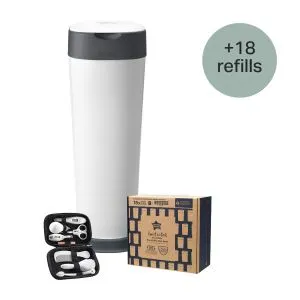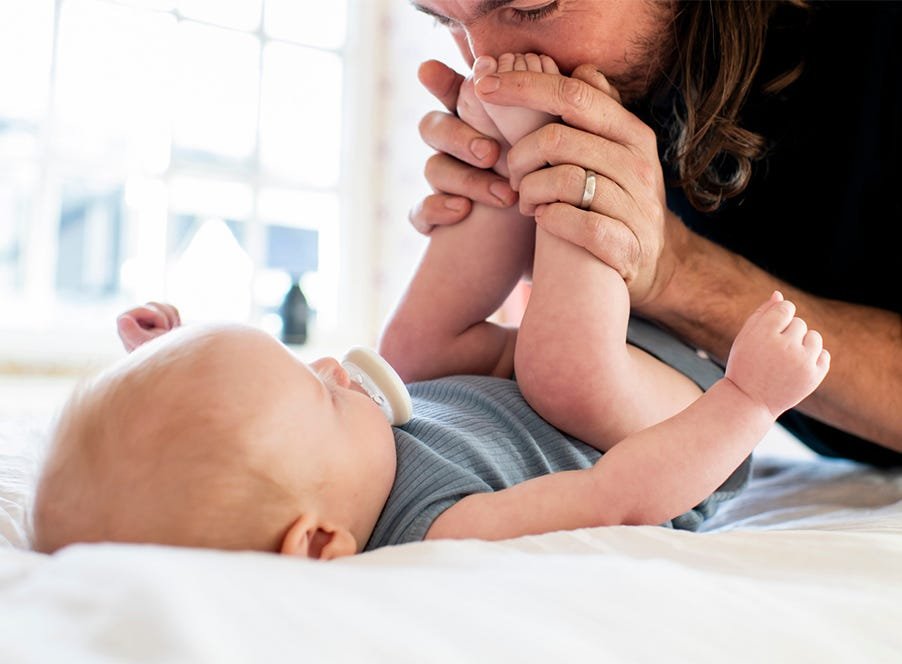
Ultimate XL Nappy Disposal Bundle with 18 Refills
Bundle & Save 40%
Subscription orders can be cancelled at anytime. Free delivery on all subsequent subscription orders. Find out more about subscriptions.
They’re easy and fuss free
Your products are automatically sent to you
You save up to 10% when you sign up for a subscription
You can cancel at any time
What is Nappy Rash?

Nappy rash… it’s sore, it’s red and it’s uncomfortable for your little one. But parents should never feel guilty if their baby does get nappy rash. It’s just part of having a baby.
Although it’s more common in bigger babies and toddlers than it is in newborns, the majority of babies will experience nappy rash at least once in the first two years of their life. We’re here to talk you through what nappy rash is, what causes it and how to treat it. Let’s get into it.
Nappy rash is an acute inflammatory reaction of the skin in the nappy area. It’s a common condition that affects babies and can present itself as a red, sore rash and spots on a baby's bottom, genitals, groin and legs (anywhere a nappy touches).
There are several causes, including contact with wee and poo for an extended period. We'll run through the others in a little while.
It’s good to know exactly what you’re looking for when it comes to nappy rash. The rash itself can range from a mild to a large rash that can spread across a baby’s bottom and thighs.
Nappy rash symptoms can be different from one baby to the next, but common symptoms include:
In severe cases, there might be specks of blood in their nappy, from irritated skin. You might also notice that your little one is fussy or seems irritated, especially when they're having a wee or a poo, or when you're changing their nappy. In other cases, they might not seem bothered at all!
While nappy rash can be unpleasant for everyone involved, there are some simple steps that parents can take to prevent and treat it.
The best way to deal with nappy rash is to try and avoid it in the first place. Here are some of the best methods of avoiding nappy rash:
It’s best to change your baby’s nappy right away as soon as you notice it’s wet or dirty. When you do change your baby’s nappy, be sure to use baby wipes that are free from fragrance or alcohol.
You should wash your baby enough to keep them clean and their skin hydrated but not too much to dry out their skin. Top and tailing can be done if your baby needs an extra clean between baths.
When cleaning your baby, it's best to avoid using soap or bubble baths, as these can cause extra irritation.
It’s important to dry your baby gently after washing them by patting – not rubbing – their skin. Also, try to avoid talcum powder, as it could irritate their delicate skin.
It’s important to make sure your baby’s nappy fits correctly. It should be snug under the belly button and the tape should be fastened evenly.
Especially after a bath, you might want to pop your baby on a towel and let them wriggle around in the nude for a while before putting them in a fresh nappy.
Anyone who changes your baby should make sure that they clean their hands thoroughly before and after every change.
Sometimes you take all the precautions in the world and can still be stuck with a little nappy rash – it happens. But don’t worry because you can almost always treat nappy rash at home.
The best thing to do is keep their nappy area clean and dry and invest in a top-notch barrier cream or ointment. Many parents swear by Sudocrem. It’s a great all-round soother and healer for your little one’s sensitive skin, as well as containing antiseptic and antibacterial properties to fight off further infections.
If you think your baby’s rash might be an allergic reaction, try to figure out if you’ve introduced any new foods or used any new products recently. The culprit is often detergent or soap!
If your baby’s nappy rash gets worse, even after several days of home treatments, is severe or occurs along with a fever, you should seek advice from your family doctor or a pharmacist to ensure that the rash isn’t infected. They’ll be able to prescribe you some medication (cream or antibiotics) to help soothe and treat the rash.
Nappy rash is commonly caused by an irritant contact dermatitis, but there are also some other common causes to look out for.
These can include:
If you’re looking to get scientific, there are a bunch of different types of nappy rash that your baby could get, some more common than others. Let's run through them one by one.
The most common type of nappy rash, irritant dermatitis is caused by a wet nappy being in contact with your baby's skin. To avoid this, you should change your baby's nappy regularly and use a solid nappy cream.
Yeast overgrowth in the nappy region is often caused by diarrhoea or tight nappies. A good nappy cream should be able to tackle this, but if not, you can always visit your doctor.
This infection is often caused when a baby's skin is already irritated, and bacteria builds in irritated areas. Antibiotics are normally needed for a bacterial infection. So, if you notice puss-filled blisters or hard scabs around their nappy area, you should consult your doctor.
Yes, according to the brand's website, Vaseline® Jelly can be applied to form a protective barrier after wiping your child's bottom clean. It can also help prevent irritants from making sore skin from nappy rash feel worse, while also locking in moisture to calm and soothe your baby's skin.
Nappy rash can take anywhere from a few days to a week or more to heal, depending on the severity of the rash and how quickly it's treated. To help healing, try to keep the affected area clean and dry, and use a barrier cream or ointment to protect the skin. If your baby's rash doesn't improve after a few days or if it appears to be getting worse, it's a good idea to consult your GP for advice.
Sometimes, other skin conditions such as eczema or a yeast infection can be mistaken for nappy rash. If you notice any unusual symptoms or if the rash does not improve with treatment, it's important to seek advice from your GP.
As we've covered, it's normal for babies to get nappy rash from time to time, and it's commonly caused by the following:
You can start using a nappy cream as a preventive measure as soon as your baby is born. Apply a thin layer of the cream to clean and dry skin before putting on a new nappy. If your baby develops a nappy rash, you can also apply the cream to the affected area after cleaning and drying it. Remember to avoid using harsh soaps or scented products that can further irritate their skin.
One of the quickest ways to cure nappy rash is to keep the affected area clean and dry. Use plain water to gently clean the area and pat it dry with a soft towel. Apply a thin layer of protective cream or ointment to the affected area to help soothe and protect the skin. Avoid using harsh soaps, scented products, or tight-fitting clothing that can irritate the skin further. If the rash persists or worsens, it's best to consult your GP for further advice.